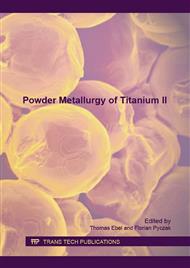[1]
G. Wen, P. Cao, B. Gabbitas, D. Zhang, N. Edmonds, Development and design of binder systems for titanium metal injection molding: An Overview, Metallurgical and Materials Transactions A 44 (2012) 1530-47.
DOI: 10.1007/s11661-012-1485-x
Google Scholar
[2]
G. Chen, P. Cao, G. Wen, N. Edmonds, Debinding behaviour of a water soluble PEG/PMMA binder for Ti metal injection moulding, Materials Chemistry and Physics 139 (2013) 557-65.
DOI: 10.1016/j.matchemphys.2013.01.057
Google Scholar
[3]
G. Herranz, Control of carbon content in metal injection molding (MIM), in: D.F. Heaney (Editor), Handbook of metal injection molding, Woodhead Publishing, USA, 2012, pp.265-304.
DOI: 10.1533/9780857096234.2.265
Google Scholar
[4]
A. T. Sidambe, I. A. Figueroa, H. G. C. Hamilton, I. Todd, Metal injection moulding of CP-Ti components for biomedical applications, Journal of Materials Processing Technology 212 (2012) 1591-97.
DOI: 10.1016/j.jmatprotec.2012.03.001
Google Scholar
[5]
A. B. Sulong, N. Muhamad, A. Arifin, K. B. Yong, Optimizing injection parameter of metal injection molding processes using the feedstock of 16 μm stainless steel powder (SS316L), PEG, PMMA and stearic acid, J Appl Sci Res 8 (2012) 2998–3003.
Google Scholar
[6]
M. H. I. Ibrahim, N. Muhamad, A. B. Sulong, Murtadhahadi, K. R. Jamaluin, S. Ahmat, N. H. M. Nor, Water atomised stainless steel powder for micro metal injection molding: optimization of rheological properties, In: Malaysian Metallurgical Conference, 2008, UKM, Bangi, Malaysia, Asian Network for Scientific Information.
Google Scholar
[7]
M. D. Hayat, G. Wen, M. F. Zulkifli, P. Cao, Effect of PEG molecular weight on rheological properties of Ti-MIM feedstocks and water debinding behaviour, Powder Technology 270 (2015) 296-301.
DOI: 10.1016/j.powtec.2014.10.035
Google Scholar
[8]
T. -Y. Chan, S. -T. Lin, Effects of stearic acid on the injection molding of alumina, Journal of American Ceramic Society 78 (1995) 2746-52.
DOI: 10.1111/j.1151-2916.1995.tb08050.x
Google Scholar
[9]
Y. -M. Li, X. -Q. Liu, F. -H. Luo, J. -L. Yue, Effects of surfactant on properties of MIM feedstock, Transactions of Nonferrous Metals Society of China 17 (2007) 1-8.
DOI: 10.1016/s1003-6326(07)60039-9
Google Scholar
[10]
M. J. Edirisinghe, The effect of processing additives on the properties of a ceramic-polymer formulation, Ceramics International 17(1991) 89-96.
DOI: 10.1016/0272-8842(91)90037-z
Google Scholar
[11]
M. D. Hayat, G. Wen, T. Li, P. Cao, Compatibility improvement of Ti-MIM feedstock using liquid surfactant, Journal of Materials Processing Technology 224 (2015) 33-39.
DOI: 10.1016/j.jmatprotec.2015.04.027
Google Scholar
[12]
G. B. Bantchev, G. Biresaw, Elastohydrodynamics of farm-based blends comprising amphiphilic oils, in: Surfactant in Tribology, G. Biresaw and K.L. Mittal. (Eds. ), Vol. 3, CRC Press, Taylor & Francis Group: Boca Raton, FL., 2011, pp.266-296.
DOI: 10.1201/b13897-15
Google Scholar
[13]
A. T. Sidambe, I. A. Figueroa, H. G. C. Hamilton, I. Todd, Metal injection moulding of Ti-64 components using a water soluble binder, PIM Int. 4 (2010) 54-62.
Google Scholar
[14]
M. D. Hayat, T. Li, G. Wen, P. Cao, Suitability of PEG/PMMA-based metal injection moulding feedstock: An experimental study, The International Journal of Advanced Manufacturing Technology 80 (2015) 1665-1671.
DOI: 10.1007/s00170-015-7133-z
Google Scholar
[15]
M. D. Hayat, T. Li, P. Cao, Incorporation of PVP into PEG/PMMA based binder system to minimize void nucleation. Materials & Design 87 (2015) 932-938.
DOI: 10.1016/j.matdes.2015.08.131
Google Scholar
[16]
J. Lee, Intrinsic adhesion properties of poly(vinyl pyrrolidone) to pharmaceutical materials: humidity effect, Macromol Biosci 5 (2005) 1085-93.
DOI: 10.1002/mabi.200500146
Google Scholar


